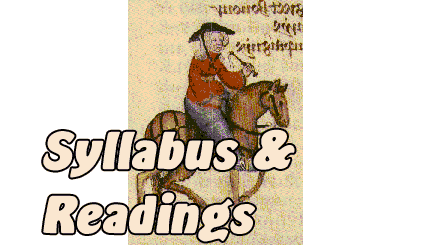

Note: some links have been removed from the archived version of this webpage
|
Tues. 1/4 |
What is pilgrimage? Where is pilgrimage? |
|
Readings |
No readings
|
|
Thur. 1/6 |
Theories of space and travel |
|
Readings |
Coleman and Elsner, Pilgrimage, 6-9 * Encyclopedia of Religion, "Pilgrimage: An Overview" * Gisbert Rinschede, "Forms of Religious Tourism," Annals of Tourism Research 19 (1992): 51-67 recommended: * Michel Foucault, "Of Other Spaces," Diacritics 16 Spring (1986): 22-27
|
|
Tues. 1/11 |
Discussion: Internet Pilgrimage? |
|
Readings
|
Visit the following sites:
"A Virtual Pilgrimage to the Holy Places in India"
For discussion: How are "space" and "presence" conveyed on these websites? Is the experience of "cyber-travel" similar to or different from "real" pilgrimage? What role does (should?) technology play in the experience of religious space?
|
|
|
First "Show and Tell" DUE |
|
Thur. 1/13 |
Judaism, I: The Temple Mount without a Temple |
|
Readings |
Coleman and Elsner, Pilgrimage, 34-51 * Danielle Storper-Perez and Harvey E. Goldberg. "The Kotel: Toward an Ethnographic Portrait." Religion 24 (1994): 309-332. Look again at "The HolyLand Model"
|
|
Tues. 1/18 |
Judaism, II: Holy Men and Mysticism |
|
Readings |
Barbara Sofer, "Frequent Prayer Points," Hadassah Magazine 83.10 (June/July 2002) Laura King, "Madonna's Pilgrimage Throws Israel into a Tizzy," Los Angeles Times Sept. 20, 2004, pg. A3 (note: Link will only work from UCR computer) Yossi Klein Halevi, "Commentary: Madonna and the Kabbalah Cult," Los Angeles Times, Sept. 24, 2004, pg. B11 (note: Link will only work from UCR computer) Gary Rosenblatt, "Madonna's Challenge to Us," The New York Jewish Week, 217.18 (Oct. 1, 2004), pg. 7 (note: Link will only work from UCR computer) recommended: * Encyclopedia of Religion, "Contemporary Jewish Pilgrimage"
|
|
Thur. 1/20 |
Christianity, I: Building the Holy Land |
|
Readings |
Coleman and Elsner, Pilgrimage, 78-99 * "The Piacenza Pilgrim"
|
|
Tues. 1/25 |
Christianity, II: Medieval Pilgrims, Penance, and Relics |
|
Readings |
Coleman and Elsner, Pilgrimage, 100-135 Geoffrey Chaucer, Canterbury Tales general prologue (Modern version)
|
|
Thur. 1/27 |
Discussion: Conrad Rudolph, Pilgrimage to the End of the World |
|
Readings
|
Conrad Rudolph, Pilgrimage to the End of the World
Special guest: Prof. Rudolph, UCR Department of Art History
For discussion: How do the visual and the spiritual coincide on pilgrimage, and how do archaic material conditions encode the pilgrimage experience for the modern traveler? Can a person participate in pilgrimage without being a "pilgrim" per se? What is the line between participant-observation and participation in the study of pilgrimage?
|
|
|
First "Response Paper" DUE |
|
Tues. 2/1 |
Islam, I: Mecca and Meaning |
|
Readings |
Coleman and Elsner, Pilgrimage, 52-73 * Selections from The Travels of Ibn Jubayr (part 1, required; part 2, optional) recommended: * Encyclopedia of Religion, "Muslim Pilgrimage"
|
|
Thurs. 2/3 |
Islam, II: Passing Muslim: Mecca and Orientalism |
|
Readings |
Coleman and Elsner, Pilgrimage, 74-77 * Selections from Sir Richard Burton, Personal Narrative of a Pilgrimage to al-Madinah and Mecca * Selections from Edward Said, Orientalism
|
|
Tues. 2/8 |
Discussion: Malcolm X at Mecca |
|
Readings |
* Selections from The Autobiography of Malcolm X (written with Alex Haley)
For discussion: How can the experience of pilgrimage be both comforting and alienating? What kinds of things does a pilgrim "learn" about him/herself, his/her "native" land, and his/her "ideal" space? How do race, class, religion, and politics intersect in Malcom's pilgrimage experience? Does the act of writing a pilgrimage narrative transform the "original" experience?
|
|
|
Second "Show and Tell" DUE |
|
|
|
|
Thurs. 2/10 |
Hinduism: By the Waters of the Ganges |
|
Readings |
Coleman and Elsner, Pilgrimage, 136-65 * Selections from Diana L. Eck, Banaras: City of Light recommended:* Diana L. Eck, "India's Tīrthas: 'Crossings' in Sacred Geography," History of Religions 20 (1981): 323-344
|
|
Tues. 2/15 |
Buddhism, I: The Buddha's Teeth and Other Relics |
|
Readings |
Coleman and Elsner, Pilgrimage, 170-180 * Selection from Fa-Hien, A Record of Buddhistic Kingdoms * Nancy Falk, "To Gaze on the Sacred Traces," History of Religions 16 (1977): 281-293
|
|
Final Project
PROPOSAL DUE
|
|
|
Thur. 2/17 |
Buddhism, II: Translocated Buddhas, from China to Japan |
|
Readings |
Coleman and Elsner, Pilgrimage, 180-195 * Chang Shang-ying, "A Further Record of Ch'ing-liang," tr. Robert M. Gimello in Pilgrims and Sacred Spaces in China * Selection from Oliver Statler, Japanese Pilgrimage
|
|
Tues. 2/22 |
Discussion: Monkey: A Chinese Folk Tale |
|
Readings |
Ch'eng-en Wu, Monkey (aka Journey to the West)
For discussion: Does using pilgrimage as an allegory (i.e., a story with a spiritual, nonliteral meaning) affirm or negate the ritual activity of pilgrimage? Or do pilgrimage allegories shape the spiritual understanding of pilgrims themselves? Does it make a difference if the allegory is "based on a true story"?
|
|
|
Second "Response Paper" DUE |
|
|
|
|
Thur. 2/24 |
NO CLASS (Professor away)
|
|
Tues. 3/1 |
Critiques of the Pilgrim: Religion and Cynicism |
|
Readings |
Mark Twain, Innocents Abroad, chs. 50, 53, 54 (pp. 525-536, 558-585)
|
|
Thur. 3/3 |
Pilgrims in Conflict: Holy Sites and Confrontation |
|
Readings |
* Roger Friedland and Richard Hecht, The Bodies of Nations: A Comparative Study of Religious Violence in Jerusalem and Ayodhya, History of Religions 38 (1998): 101-49
|
|
Tues. 3/8 |
Cultural Pilgrims: The U.S. as Holy Land |
|
Readings |
* Juan Eduardo Campo, "American Pilgrimage Landscapes," Annals of the American Academy of Political and Social Sciences 558 (1998): 40-56
|
|
Thur. 3/10 |
Conclusions and Presentations |
|
|
Conclusions and presentations of final projects
|